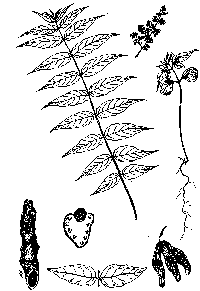|
Ailanthus altissima
|
|
|
|
Scientific name
|
Ailanthus altissima
|
|
Common name
|
ailanthus; tree-of-heaven
|
|
Synonymous scientific names
|
Ailanthus glandulosa, Toxicodendron altissinum
|
|
Closely related California natives
|
0
|
|
Closely related California non-natives:
|
0
|
|
Listed
|
CalEPPC List B,CDFA nl
|
|
By:
|
John Hunter
|
|
Distribution
|
|
|
HOW DO I RECOGNIZE IT?
Distinctive features:
|
Ailanthus (Ailanthus altissima) is a deciduous tree thirty to sixty-five feet high, with gray bark, and generally with root sprouts. Its branches have a large pith and prominent heart-shaped leaf scars. Ailanthus has large compound leaves with several circular glands on the underside of most leaflets. The crushed foliage has an unpleasant odor. Flowers, which are small, greenish, and in large clusters at the branch tips, develop into conspicuous and distinctive clusters of fruits. The dry straw-colored or reddish brown fruits are winged with a single seed in the center, their shape resembling an airplane propeller.
|
|
Description:
|
|
Simaroubaceae. Bark: gray and more or less smooth, but develops shallow diamond-shaped fissures with age. Branches have a large pith, alternate leaves, and prominent heart-shaped leaf scars. Leaves: pinnate compound, and 1-3+ ft (30-90+ cm) long with 10-40 lanceolate leaflets. Leaflets have 2-4 rounded teeth near the base, most with a round gland on the lower surface. Inflorescence: large at branch tips. Flowers: small, unisexual, and yellow-green. Flower parts can vary in number, but typically flowers have 5 sepals, 5 petals, 10 functional stamens in male flowers, and 2-5 carpels in female flowers. Female flowers ill-smelling. Each carpel can mature into a winged fruit containing a single central seed. Fruits: dry, indehiscent, 1-2 in (2.5-5 cm) long, propeller-shaped, and straw-colored or reddish brown. (Description based on Bailey 1949, Harlow et al. 1979, McClintock 1993).
|
|
|
|
WHERE WOULD I FIND IT?
|
Ailanthus is widely but discontinuously distributed in
California. It is most abundant along the coast and in the Sierra foothills,
primarily in wastelands and disturbed, semi-natural habitats. However, it also
occurs in riparian areas and other naturally disturbed habitats throughout
California’s mid-lower elevations, below 6,600 feet (2000 m). For example, it is
found in disturbed woodland and grassland at John Muir National Monument, along
a creek bed at the Carrizo Plain, and in the riparian zone of the American and
Sacramento rivers. It grows in humid and sub-humid, temperate regions, mainly on
clay or loam soils in areas with moderate rainfall. Ailanthus is tolerant of
extreme soil conditions (Miller 1990). The tree has been used in revegetating
acid mine spoils, tolerating a pH of less than 4.1, soluble salt concentrations
up to 0.25 mmhos/cm, and phosphorus levels as low as 1.8 ppm (Plass 1975). It
withstands harsh urban environments better than most plants and is used as a
street tree in many cities.
|
|
WHERE DID IT COME FROM AND HOW IS IT SPREAD?
|
A native of eastern China, ailanthus has been introduced
throughout the northern hemisphere. In the 1740s it was introduced to Europe in
the mistaken belief that it was the source of lacquer used in the production of
polished wooden ware (Hu 1979). Because of its tropical look, rapid growth, and
legendary tolerance of urban life, ailanthus was planted throughout Europe and
the United States during the nineteenth century. In California it was planted
widely until the 1890s (McClintock 1981). During the days of the California gold
rush, Chinese miners also may have brought ailanthus seeds with them as they
settled in California. In this century, its popularity as an ornamental has
declined primarily because of its unpleasant fragrance and prolific root
sprouting. Today, it is still occasionally planted in California (Perry 1989).
Ailanthus escapes from cultivation and spreads by root sprouts
and wind-dispersed seeds. Seeds may also spread by water, birds, and on farm
machinery. However, new patches do not occur as frequently as would be expected
from the amount of seed produced (Parsons 1992).
|
|
WHAT PROBLEMS DOES IT CAUSE?
|
By producing abundant root sprouts, ailanthus creates thickets
of considerable area, displacing native vegetation (Kowarik 1983, 1995).
Although it may suffer from root competition by other trees already established,
usually it competes successfully with other plants (Cozzo 1972, Hu 1979). In
California its most significant displacement of native vegetation is in riparian
zones. It also produces allelopathic chemicals that may contribute to
displacement of native vegetation (Lawrence 1991). A high degree of shade
tolerance gives ailanthus a competitive edge over other plant species (Grime
1965).
|
|
HOW DOES IT GROW AND REPRODUCE?
|
Ailanthus reproduces by seed and vegetatively by root
sprouts. Trees generally become reproductive at ten to twenty years, but younger
shoots also may produce fruits. Trees are deciduous, leaving clumps of stark,
bare stems over the winter. Most trees produce only male or only female flowers
(dioecy). Flowering follows leaf expansion in late spring. Female trees may
produce several hundred inflorescences per year, and at maturity an
inflorescence contains hundreds of seeds (Hunter 1995). A single tree can
produce up to a million seeds per year. Seeds ripen in large, crowded clusters
from September to October of the same year and may persist on the tree through
the following winter (Little 1974, Hu 1979). Most ailanthus seeds are viable,
even those that have overwintered on the tree (Little 1974, Hunter 1995). Fruits
are winged, containing a single light seed. The fruits mature in late summer and
are dispersed by wind throughout fall, winter, and even during the following
spring. After exposure to cold temperatures of 32 to 42 degrees F for more than
forty days, seed will germinate readily in moist soil (Little 1974). Germination
ranges from 14 to 75 percent. Because its seeds do not remain dormant for more
than a year, ailanthus does not have a persistent soil seedbank. Despite
prolific seed production, seedling establishment of ailanthus is infrequent in
California. Most new shoots are root sprouts. Young root sprouts are
distinguished by a cluster of leaves with a variable number of leaflets attached
to a thick rope-like root, whereas seedlings are thin-stemmed and have round
cotyledons followed by trifoliate leaves. Root sprouts are produced up to fifty
feet (15 m) away from the nearest shoot. Their initial growth is rapid, commonly
over a meter per year (Miller 1990, Hunter unpubl. data). In favorable settings,
rapid growth continues, but for shaded sprouts growth drops to several
centimeters per year (Hunter unpubl. data).
| Initially, growth is concentrated
along a single axis and branching is rare. Even when browsed or cut, most
stems continue to grow with a single main trunk. Damage, however, often
gives rise to root sprouts (Bailey 1930). Once branching begins, the
branches diverge at wide angles and a broad dome-shaped crown develops.
Within twelve to twenty-five years, the tree typically reaches heights of
thirty-three to sixty-three feet (10-20 m) in California. |
(click on photos to view larger image)
|
Ailanthus shoots typically have a life span of thirty to fifty years
(Miller 1990), but production of multiple trunks from root sprouts allows
genetic individuals to occupy a considerable area, sometimes over an acre (0.4
ha), for a prolonged period of time.
|
|
HOW CAN I GET RID OF IT?
|
|
|
Physical control:
|
If mechanical and/or chemical control is
attempted, sites should be monitored several times per growing season. All new
root sprouts should be removed, and monitoring should be continued for one year
after the last sprout is removed.
Hand pulling: Young seedlings are best pulled after a
rain when the soil is loose. This allows removal of the root system, which may
resprout if left in the ground. After the tap root has developed, root removal
is more difficult. Plants should be pulled as soon as they are large enough to
grasp but before they produce seeds.
Hand digging: Removal of rootstocks by hand digging is a
slow but sure way of destroying weeds that resprout from roots. The work must be
thorough to be effective as every piece of root that breaks off and remains in
the soil may produce a new plant. This technique is suitable only for small
infestations and around trees and shrubs where other methods are not practical.
Cutting: Manually operated tools such as brush cutters,
power saws, axes, machetes, loppers, and clippers can be used to cut ailanthus.
This is an important step before many other methods are tried, as it removes the
above-ground portion of the plant. For thickly growing, multi-stemmed shrubs and
trees, access to the base of the plant may be not only difficult but dangerous
where footing is uncertain.
Girdling: This involves manually cutting away bark and
cambial tissues around the trunks of undesirable trees. A relatively inexpensive
method, girdling is done with an ordinary ax in spring when trees are actively
growing. Hardwoods are known to resprout below the girdle unless the cut is
treated with herbicides. Although it may be undesirable to leave standing dead
trees in some areas, this technique has been shown to reduce stump sprouting in
live oaks, and may be a useful technique for controlling ailanthus.
Cutting an ailanthus stem induces prolific root suckering and
the production of stump sprouts. After a stem is cut, its stump sprouts may grow
over ten feet (3 m) per year and its root sprouts three to seven feet (1-2 m)
per year (Pannill 1995). As a consequence, mechanical removal will be
ineffective unless all stems are cut at least several times per year (Pannill
1995).
Prescribed burning: This is probably not an effective technique for controlling
ailanthus. Fire may kill main stems, but this will result in prolific
sprouting.
|
|
Biological control:
|
Insects and fungi:
Biological control of ailanthus has not been investigated. The species is not
significantly affected by insects or disease (Miller 1990). French (1972)
reports that the zonate leafspot fungus (Cristulariella pyramidalis) causes
defoliation of ailanthus in Florida. In India the insect Atteva fabricella is
considered an ailanthus defoliator (Misra 1978), and seedlings in Italy,
weakened by cold, were weakly parasitized by the fungus Placosphaeria sp.
(Magnani 1975).
Grazing: Ailanthus may suffer extensive browse herbivory
from deer and cattle, particularly the young growth of sprouts, which may aid
eradication (Pannill 1995, Hunter 1995).
Plant competition: In most cases ailanthus prevents the establishment of other native plants
and must be initially removed. Following removal of mature plants, root crowns
must be treated to prevent resprouting. Seedlings of native plant species
usually cannot establish fast enough to compete with sprout growth from
untreated stumps. Ailanthus is shade tolerant, so presumably will sprout under
other plants.
|
|
Chemical control:
|
Herbicide applications should be most
effective in spring, just after leaves are fully expanded. Smaller sprouts
probably can be controlled by spraying foliage with 4 percent glyphosate (as
Roundupå¨). Young stems usually can be killed by generously applying 15-20
percent triclopyr (sold as Garlonå¨) to all of the bark from the stem base to
twenty inches above the ground. The thicker bark of larger plants interferes
with uptake of herbicide, and therefore, to kill larger individuals, the stem
needs to be frilled (have an encircling ring of bark removed) before herbicide
is applied. In order to damage the root system, concentrated herbicide (such as
15 to 20 percent triclopyr or 15 to 40 percent glyphosate) needs to be applied
with brush or wick to the freshly exposed surface immediately after cutting
(Pannill 1995). Applying herbicide to freshly cut stumps is probably the most
effective technique for controlling ailanthus. Wiping the stump with full
strength, 41 percent glyphosate within several minutes of cutting should reduce
or even eliminate subsequent root suckering.
|




